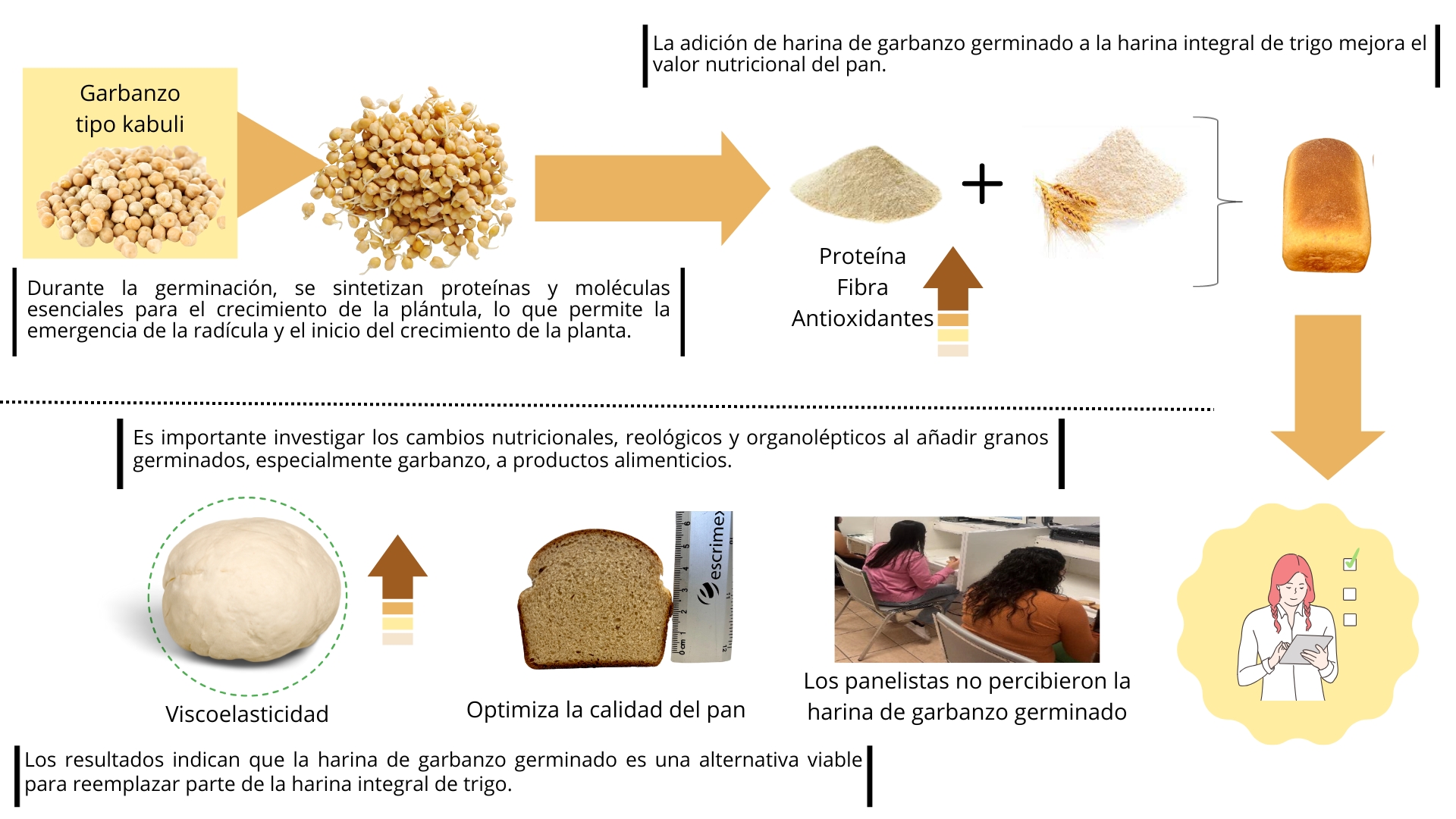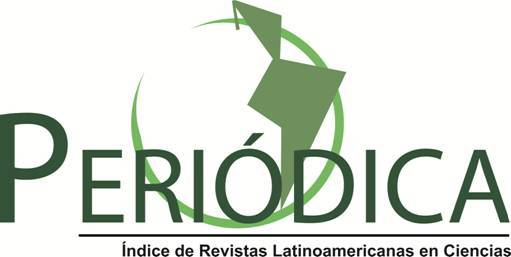Whole wheat (Triticum aestivum L.) flour added with chickpea (Cicer arietinum L.) flour germinated through hydroponics: rheological, texture, and sensory analysis in a baked product
DOI:
https://doi.org/10.18633/biotecnia.v27.2484Keywords:
Cicer arietinum L., Germination, Flours, BakingAbstract
Investigating the rheological, textural, and sensory changes resulting from the addition of chickpea flour to bakery products is crucial. Furthermore, bioprocessing methods, such as hydroponic germination, should be analyzed to evaluate their impact on dough rheology and bread quality. In this study, proximal analysis of chickpea flour was conducted, and its viscoelastic properties were assessed. The specific volume of the resulting bakery product was measured, and a texture profile analysis (TPA) was performed. A discriminative sensory analysis, using a triangular test, evaluated whether consumers detected sensory differences due to changes in ingredients. The results showed increased protein and ash content, increased viscoelasticity in germinated chickpea flour, higher specific volume in bread with chickpea flour, and reduced bread hardness when chickpea flour—germinated or non-germinated—was used as a replacement. Sensory analysis revealed no significant differences (Pd = 30 %, α = 0.05, β = 0.05) between treatments with germinated and non-germinated chickpea flour. These findings suggest that germinated chickpea flour is a viable alternative for replacing whole-grain wheat flour while preserving the product’s sensory acceptability.
Downloads
References
AACC, 2000. Approved Methods of American Association of Cereal Chemists. 10th Ed. The Associa-tion, St. Paul, Minnesota, USA. Methods 56-11.02, 76-21.02
Aguilar-Raymundo, V.G., y Vélez-Ruiz, J.F. 2013. Propiedades nutricionales y funcionales del garbanzo (Cicer arietinum L.). Temas Selectos de Ingeniería de Alimentos, 7: 2, 25-34.
Atudorei, D., Stroe, S.-G., y Codină, G. G. 2020. Physical, physiological and minerals changes of dif-ferent legumes types during the germination process. Ukrainian food journal, 9: 4, 844–863.
Atudorei, D., Atudorei, O., y Codină, G. G. 2022. The impact of germinated chickpea flour addition on dough rheology and bread quality. Plants, 11: 9, 1225.
Begum, N., Khan, Q. U., Liu, L. G., Li, W., Liu, D., y Haq, I. U. 2023. Nutritional composition, health benefits and bio-active compounds of chickpea (Cicer arietinum L.). Frontiers in nutrition, 10.
Chandora, R., Gayacharan, Shekhawat, N., y Malhotra, N. 2020. Chickpea genetic resources: collection, conservation, characterization, and maintenance. Chickpea: Crop Wild Relatives for Enhancing Genetic Gains. 37–61.
Cunha, L. M., Fonseca, S. C., Lima, R. C., Loureiro, J., Pinto, A. S., Vaz Patto, M. C., y Brites, C. 2019. Consumer-driven improvement of maize bread formulations with legume fortification. Foods (Basel, Switzerland), 8: 7, 235.
Eraslan, H., Wehbeh, J., y Ermis, E. 2023. Effect of sourdough prepared with the combination of chickpea and carob on bread properties. International Journal of Gastronomy and Food Science, 32: 100753.
FAO. La Organización de las Naciones Unidas para la Alimentación y la Agricultura. 2021. Beneficios nutricionales de las legumbres. © FAO 2021 I5384ES/2/02.21
Ferreira, C. D., Bubolz, V. K., da Silva, J., Dittgen, C. L., Ziegler, V., de Oliveira Raphaelli, C., y de Oliveira, M. 2019. Changes in the chemical composition and bioactive compounds of chickpea (Cicer arietinum L.) fortified by germination. Lebensmittel-Wissenschaft Und Technologie [Food Science and Technology], 111: 363–369.
Gerardo-Rodríguez, J. E., Ramírez-Wong, B., Torres-Chávez, P. I., Ledesma-Osuna, A. I., Carva-jal-Millan, E., López-Cervantes, J., Vásquez-Lara, F., Silvas-García, M. I. 2019. Viscoelastic char-acteristics of part-baked bread under different process conditions. Biotecnia, 21: 1, 68-78.
Godínez, J.R. y Sánchez, J.E.O. 2020. Aplicación de una prueba triangular en muestras de alimentos. Boletín Científico de las Ciencias Económicas Administrativas del ICEA, 9: 17, 15-17.
Guardado-Félix, D., Lazo-Vélez, M. A., Pérez-Carrillo, E., Panata-Saquicili, D. E., y Serna-Saldívar, S. O. 2020. Effect of partial replacement of wheat flour with sprouted chickpea flours with or without selenium on physicochemical, sensory, antioxidant and protein quality of yeast-leavened breads. Lebensmittel-Wissenschaft Und Technologie [Food Science and Technology], 129:109517.
Guerrero Segura, D.C. y Llerena Carrera, C.A. 2015. Efecto del tiempo de germinación en las caracte-rísticas reológicas de la masa de pan con harina de arroz variedad INIAP XV. Trabajo final para la obtención del título: Ingenieros de Alimentos. Espol Fimcp, Guayaquil. 82.
Kaur, R., y Prasad, K. 2021. Technological, processing and nutritional aspects of chickpea (Cicer ari-etinum) - A review. Trends in Food Science y Technology, 109, 448–463.
King, J., Leong, S. Y., Alpos, M., Johnson, C., McLeod, S., Peng, M., Sutton, K., y Oey, I. 2024. Role of food processing and incorporating legumes in food products to increase protein intake and enhance satiety. Trends in Food Science y Technology, 147: 104466.
Kotsiou, K., Sacharidis, D.-D., Matsakidou, A., Biliaderis, C. G., y Lazaridou, A. 2022. Physicochemical and functional aspects of composite wheat-roasted chickpea flours in relation to dough rheology, bread quality and staling phenomena. Food Hydrocolloids, 124:107322.
Magaña-Barajas, E., Ramírez-Wong, B., Platt-Lucero, L., López-Ahumada, G., Torres, P., Sánchez, I., y Machado, D. 2009. Características viscoelásticas de la masa procedente de cultivares de trigo blando. Tecnología. Ciencia y Educación, 24, 12-22.
Mao, H., Yuan, S., Li, Q., Zhao, X., Zhang, X., Liu, H., Yu, M., y Wang, M. 2024. Influence of ger-mination on the bioactivity, structural, functional and volatile characteristics of different chickpea flours. Food Chemistry: X, 21: 101195.
Mazón, NVC, Yacelga, JCS, Machado, ERR, Murillo, PLG, y Mena, MEC (2018). Uso de pruebas afectivas, discriminatorias y descriptivas de evaluación sensorial en el campo gastronómico. Dominio de las Ciencias, 4: 3, 253-263.
Meilgaard, M. C., Thomas Carr, B., y Civille, G. V. 2006. Sensory Evaluation Techniques, Fourth Edi-tion. CRC Press. ISBN-13: 978-0-8493-3839-7.
Mohammed, I., Ahmed, A. R., y Senge, B. 2014. Effects of chickpea flour on wheat pasting properties and bread making quality. Journal of Food Science and Technology, 51:9, 1902–1910.
Pavlovich-Abril A., Rouzaud-Sández O., Torres P. y Robles-Sánchez R.M. 2012. Cereal bran and wholegrain as a source of dietary fibre: technological and health aspects. International Journal of Food Sciences and Nutrition, Early Online: 1–11.
Sciarini L.S., Steffolani M.E. y León A.E. 2016. El rol del gluten en la panificación y el desafío de prescindir de su aporte en la elaboración de pan. AgriScientia, 33: 2: 61-74.
Sofi, S. A., Singh, J., Muzaffar, K., Mir, S. A., y Dar, B. N. 2020. Effect of germination time on phys-ico-chemical, functional, pasting, rheology and electrophoretic characteristics of chickpea flour. Journal of Food Measurement y Characterization, 14:5, 2380–2392.
Sofi S.A., Rafiq S., Singh J., Ahmad Mir S., Sharma S., Bakshi P., McClementsf D.J., Khaneghah A.M., Dar B.N. 2023. Impact of germination on structural, physicochemical, techno-functional, and di-gestion properties of desi chickpea (Cicer arietinum L.) flour. Food Chemistry 405: 135011.
Soto Toloza, E. P., Mora Acevedo, S. N., y Caballero Pérez, L. A. 2024. Efecto de la sustitución parcial de harina de trigo (Triticum vulgare) por harina de garbanzo (Cicer arietinum L) en las características sensoriales de una galleta dulce. Revista Ambiental Agua, Aire y Suelo, 14:1, 39–54.
Sulieman, A., Moneim, E., Enas, A., y Sinada Y Ali, O. 2013. Quality Characteristics of Wheat Bread Supplemented with Chickpea (Cicer arietinum) Flour. International Journal of Food Science and Nutrition Engineer ing, 3:5: 85-90.
Teixeira R., da Silva S.C., Sousa Silva L., da Silva W.A., Arruda Gonçalves A.C., Vieira Pires C., Dias Martins A.M., Hidalgo Chávez D.W., Machado Trombete F. 2020. Whole chickpea flour as an in-gredient for improving the nutritional quality of sandwich bread: Effects on sensory acceptance, texture profile, and technological properties. Revista Chilena de Nutrición; 47: 6: 933-940.
Torres-González, M. P., Jiménez-Munguía, M. T. y Bárcenas-Pozos, M. E. 2014. Harinas de frutas y/o leguminosas y su combinación con harina de trigo. Temas selectos de Ingeniería de Alimentos. Vol. 8 - 1: 94 – 102
Vásquez-Castillo G.M., Matos-Chamorro A. 2009. Evaluación de Algunas Características Fisicoquímicas de Harina de Trigo Peruano en Función a su Calidad Panadera. Revista de Investigación Universi-taria, 1:1
Vásquez-Fon Fay, F.M. y Fernández-Zumbado, H. 2019. Análisis proximal en alimentos. Fundamentos teóricos y técnicas experimentales. Editado por Colloquium. Primera edición. ISBN: 978-9942-814-28-9
Villanueva Flores, R. 2014. El gluten del trigo y su rol en la industria de la panificación. Ingeniería In-dustrial No 32, ISSN 1025-9929, pp. 231-246.
Wang, J., Li, Y., Li, A., Liu, R. H., Gao, X., Li, D., Kou, X., y Xue, Z. 2021. Nutritional constituent and health benefits of chickpea (Cicer arietinum L.): A review. Food Research International (Ottawa, Ont.), 150: 110790.
Wang, Y., y Jian, C. 2022. Sustainable plant-based ingredients as wheat flour substitutes in bread making. Npj Science of Food, 6: 49.
Wang, A., Zhu, Y., Zou, L., Zhao, G., y Wu, J. 2023. Development of protein-enriched biscuit based on oat-milk byproduct fortified with chickpea flour. Lebensmittel-Wissenschaft Und Technologie [Food Science and Technology], 177:114594.

Downloads
Published
How to Cite
Issue
Section
License
Copyright (c) 2025

This work is licensed under a Creative Commons Attribution-NonCommercial-ShareAlike 4.0 International License.
The journal Biotecnia is licensed under the Attribution-NonCommercial-ShareAlike 4.0 International (CC BY-NC-SA 4.0) license.




_(1)_(1).png)






_(2).jpg)





